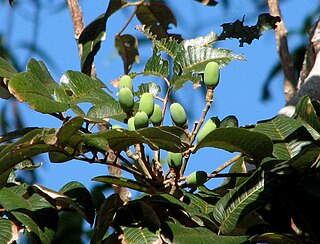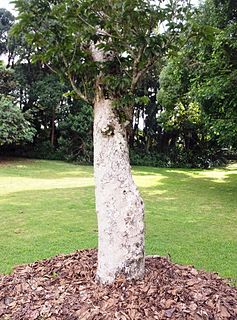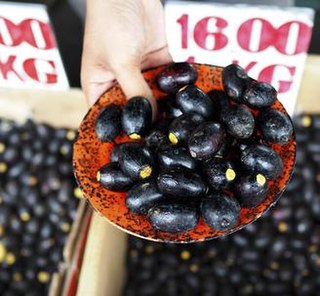
Canarium is a genus of about 100 species of tropical and subtropical trees, in the family Burseraceae. They grow naturally across tropical Africa, south and southeast Asia, Indochina, Malesia, Australia and western Pacific Islands; including from southern Nigeria east to Madagascar, Mauritius, Sri Lanka and India; from Burma, Malaysia and Thailand through the Malay Peninsula and Vietnam to south China, Taiwan and the Philippines; through Borneo, Indonesia, Timor and New Guinea, through to the Solomon Islands, New Caledonia, Fiji, Samoa, Tonga and Palau.

Canarium australianum is a species of trees, native to Australia and Papua New Guinea, of the plant family Burseraceae. Common names include mango bark, scrub turpentine, carrot wood, parsnip wood, Melville Island white beech and brown cudgerie.

Canarium asperum is a species of plant in the family Burseraceae. It is found in Brunei, Indonesia, Malaysia, Papua New Guinea, the Philippines, and the Solomon Islands.
Canarium kipella is a species of plant in the Burseraceae family. It is endemic to Java in Indonesia. It is an endangered species threatened by habitat loss.
Canarium littorale is a tree found in tropical Asia and is a member of the incense tree family Burseraceae. The specific epithet littorale is from the Latin meaning "of the seashore", referring to its habitat.

Canarium paniculatum is a species of flowering plant in the family Burseraceae. It is endemic to Mauritius.
Canarium patentinervium is a tree of tropical Asia in the incense tree family Burseraceae. The specific epithet patentinervium is from the Latin meaning "spreading nerves", referring to the leaf veins.
Canarium pseudopatentinervium is a tree of tropical Asia in the incense tree family Burseraceae. The specific epithet pseudopatentinervium is from the Latin meaning "false patentinervium", referring to the species' resemblance to Canarium patentinervium.
Canarium pseudosumatranum is a species of plant in the Burseraceae family. It is a tree endemic to Peninsular Malaysia. It is threatened by habitat loss.
Canarium reniforme is a species of plant in the Burseraceae family. It is a tree endemic to Peninsular Malaysia. It is threatened by habitat loss.
Canarium whitei is a species of plant in the Burseraceae family. It is endemic to New Caledonia.

Canarium zeylanicum is a species of flowering plant in the frankincense family, Burseraceae, that is endemic to Sri Lanka.

Canarium odontophyllum is a fruit-bearing tree of the genus Canarium in the family Burseraceae. It is a native of Sarawak. It grows up to a height of 40 to 50 meters. Its fruit is a prized seasonal delicacy in Sarawak. The outer skin is glossy black colour while the flesh is yellow with an elongated seed. The fruit is hard and inedible when ripe and must be soaked in warm water before eating. It tastes of avocado and is seasoned with salt or soy sauce.

Canarium decumanum is a tree in the family Burseraceae. The specific epithet decumanum is from the Latin meaning "greatest", referring to the tree's size.
Canarium grandifolium is a tree in the family Burseraceae. The specific epithet grandifolium is from the Latin meaning "large leaf".
Canarium hirsutum is a tree in the family Burseraceae. The specific epithet hirsutum is from the Latin meaning "bristly", referring to the rough hairs of the fruit.
Canarium denticulatum is a tree in the family Burseraceae. The specific epithet denticulatum is from the Latin meaning "small teeth", referring to the leaf margin.
Canarium pilosum is a tree in the family Burseraceae. The specific epithet pilosum is from the Latin meaning "hairy", referring to the soft hairs of the twigs and leaves.
Canarium pilosum subsp. borneensis is a subspecies of Canarium pilosum. It is a tree in the family Burseraceae. The subspecies is named for Borneo.







